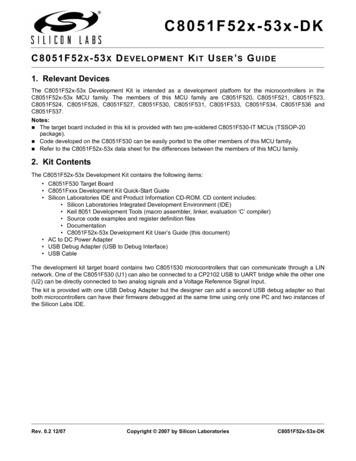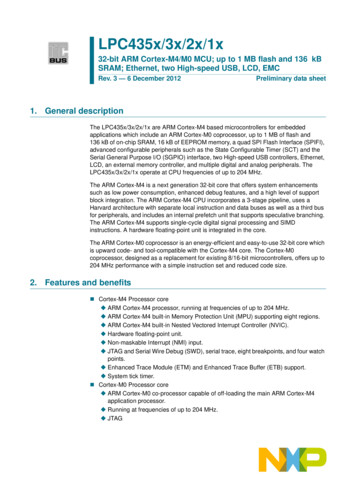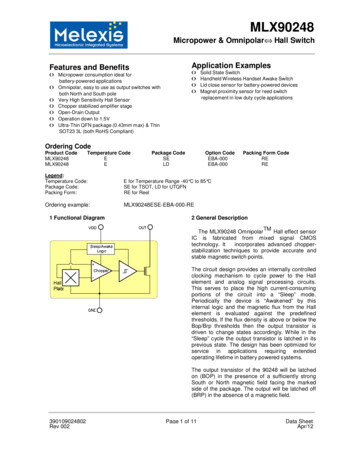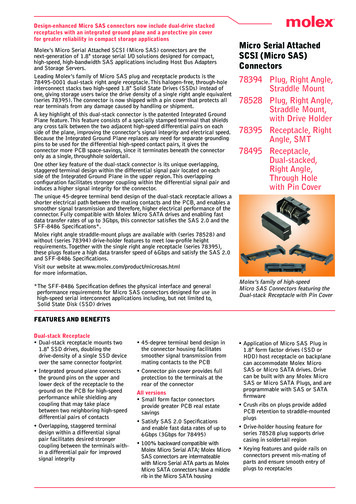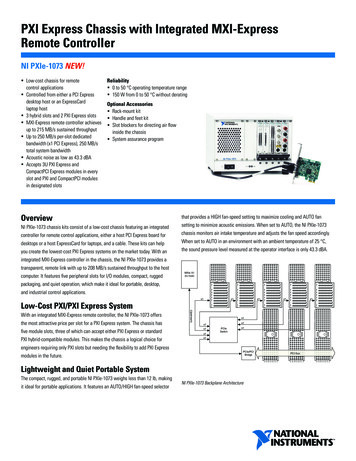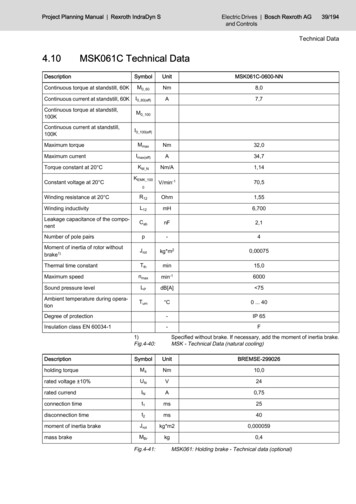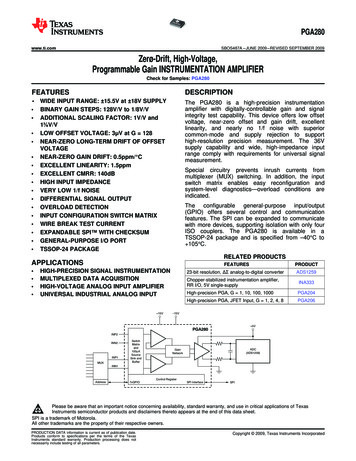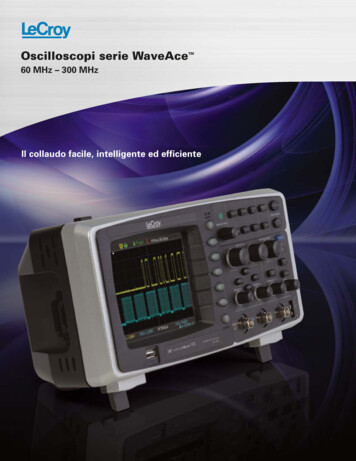Transcription
C8051F34x-DKC8051F34 X D E V E L O P M E N T K I T U S E R ’ S G U I D E1. Kit ContentsThe C8051F34x Development Kit contains the following items: C8051F340 Target Board C8051Fxxx Development Kit Quick-start Guide Silicon Laboratories IDE and Product Information CD-ROM. CD content includes: Silicon Laboratories Integrated Development Environment (IDE) Keil 8051 Development Tools (macro assembler, linker, evaluation ‘C’ compiler) Source code examples and register definition files Documentation C8051F34x Development Kit User’s Guide (this document) AC to DC Power Adapter USB Debug Adapter (USB to Debug Interface) USB Cable2. Hardware Setup using a USB Debug AdapterThe target board is connected to a PC running the Silicon Laboratories IDE via the USB Debug Adapter as shownin Figure 1.1.2.3.4.Connect the USB Debug Adapter to the DEBUG connector on the target board with the 10-pin ribbon cable.Connect one end of the USB cable to the USB connector on the USB Debug Adapter.Connect the other end of the USB cable to a USB Port on the PC.Connect the ac/dc power adapter to power jack P1 on the target board.Notes: Use the Reset button in the IDE to reset the target when connected using a USB Debug Adapter. Remove power from the target board before removing the ribbon cable from the target board. Connecting ordisconnecting the cable when the devices have power can damage the device and/or the USB DebugAdapter.AC/DCAdapterPCTarget BoardUSB Debug AdapterPWRSILICON LABORATORIESRESET P3.7RunStopSilicon LaboratoriesUSB DEBUG ADAPTERPowerUSBCableMCUP1.6Port 2Port 0Port 1Port 3Port 4Figure 1. Hardware Setup using a USB Debug AdapterRev. 0.2 9/06Copyright 2006 by Silicon LaboratoriesC8051F34x-DK
C8051F34x-DK3. Software SetupThe included CD-ROM contains the Silicon Laboratories Integrated Development Environment (IDE), Keil software8051 tools and additional documentation. Insert the CD-ROM into your PC’s CD-ROM drive. An installer willautomatically launch, allowing you to install the IDE software or read documentation by clicking buttons on theInstallation Panel. If the installer does not automatically start when you insert the CD-ROM, run autorun.exe foundin the root directory of the CD-ROM. Refer to the readme.txt file on the CD-ROM for the latest informationregarding known IDE problems and restrictions.4. Silicon Laboratories Integrated Development EnvironmentThe Silicon Laboratories IDE integrates a source-code editor, source-level debugger and in-system Flashprogrammer. The use of third-party compilers and assemblers is also supported. This development kit includes theKeil Software A51 macro assembler, BL51 linker and evaluation version C51 ‘C’ compiler. These tools can be usedfrom within the Silicon Laboratories IDE.4.1. System RequirementsThe Silicon Laboratories IDE requirements: Pentium-class host PC running Windows 2000 or Windows XP. One available COM or USB port. 64 MB RAM and 40 MB free HD space recommended.4.2. Assembler and LinkerA full-version Keil A51 macro assembler and BL51 banking linker are included with the development kit and areinstalled during IDE installation. The complete assembler and linker reference manual can be found under the Helpmenu in the IDE or in the “SiLabs\MCU\hlp” directory (A51.pdf).4.3. Evaluation C51 ‘C’ CompilerAn evaluation version of the Keil C51 ‘C’ compiler is included with the development kit and is installed during IDEinstallation. The evaluation version of the C51 compiler is the same as the full professional version except codesize is limited to 4 kB and the floating point library is not included. The C51 compiler reference manual can befound under the Help menu in the IDE or in the “SiLabs\MCU\hlp” directory (C51.pdf).4.4. Using the Keil Software 8051 Tools with the Silicon Laboratories IDETo perform source-level debugging with the IDE, you must configure the Keil 8051 tools to generate an absoluteobject file in the OMF-51 format with object extensions and debug records enabled. You may build the OMF-51absolute object file by calling the Keil 8051 tools at the command line (e.g. batch file or make file) or by using theproject manager built into the IDE. The default configuration when using the Silicon Laboratories IDE projectmanager enables object extension and debug record generation. Refer to Applications Note AN104 - IntegratingKeil 8051 Tools Into the Silicon Labs IDE in the “SiLabs\MCU\Documentation\Appnotes” directory on the CDROM for additional information on using the Keil 8051 tools with the Silicon Laboratories IDE.To build an absolute object file using the Silicon Laboratories IDE project manager, you must first create a project.A project consists of a set of files, IDE configuration, debug views, and a target build configuration (list of files andtool configurations used as input to the assembler, compiler, and linker when building an output object file).The following sections illustrate the steps necessary to manually create a project with one or more source files,build a program and download the program to the target in preparation for debugging. (The IDE will automaticallycreate a single-file project using the currently open and active source file if you select Build/Make Project before aproject is defined.)2Rev. 0.2
C8051F34x-DK4.4.1. Creating a New Project1. Select Project New Project to open a new project and reset all configuration settings to default.2. Select File New File to open an editor window. Create your source file(s) and save the file(s) with a recognized extension, such as .c, .h, or .asm, to enable color syntax highlighting.3. Right-click on “New Project” in the Project Window. Select Add files to project. Select files in the filebrowser and click Open. Continue adding files until all project files have been added.4. For each of the files in the Project Window that you want assembled, compiled and linked into the targetbuild, right-click on the file name and select Add file to build. Each file will be assembled or compiled asappropriate (based on file extension) and linked into the build of the absolute object file.Note: If a project contains a large number of files, the “Group” feature of the IDE can be used to organize.Right-click on “New Project” in the Project Window. Select Add Groups to project. Add pre-definedgroups or add customized groups. Right-click on the group name and choose Add file to group. Select filesto be added. Continue adding files until all project files have been added.4.4.2. Building and Downloading the Program for Debugging1. Once all source files have been added to the target build, build the project by clicking on the Build/MakeProject button in the toolbar or selecting Project Build/Make Project from the menu.Note: After the project has been built the first time, the Build/Make Project command will only build thefiles that have been changed since the previous build. To rebuild all files and project dependencies, clickon the Rebuild All button in the toolbar or select Project Rebuild All from the menu.2. Before connecting to the target device, several connection options may need to be set. Open theConnection Options window by selecting Options Connection Options. in the IDE menu. First, selectthe appropriate adapter in the “Serial Adapter” section. Next, the correct “Debug Interface” must be selected.C8051F34x family devices use the Silicon Labs 2-wire (C2) debug interface. Once all the selections aremade, click the OK button to close the window.3. Click the Connect button in the toolbar or select Debug Connect from the menu to connect to the device.4. Download the project to the target by clicking the Download Code button in the toolbar.Note: To enable automatic downloading if the program build is successful select Enable automatic connect/download after build in the Project Target Build Configuration dialog. If errors occur during thebuild process, the IDE will not attempt the download.5. Save the project when finished with the debug session to preserve the current target build configuration,editor settings and the location of all open debug views. To save the project, select Project- Save ProjectAs. from the menu. Create a new name for the project and click on Save.Rev. 0.23
C8051F34x-DK5. Example Source CodeExample source code and register definition files are provided in the “SiLabs\MCU\Examples\C8051F34x”directory during IDE installation. These files may be used as a template for code development. Exampleapplications include a blinking LED example which configures the green LED on the target board to blink at a fixedrate. A Universal Serial Bus (USB) application example is also included with the C8051F34x development kit.5.1. Register Definition FilesRegister definition files C8051F340.inc and C8051F340.h define all SFR registers and bit-addressable control/status bits. They are installed into the “SiLabs\MCU\Examples\C8051F34x” directory during IDE installation. Theregister and bit names are identical to those used in the C8051F34x datasheet. Both register definition files arealso installed in the default search path used by the Keil Software 8051 tools. Therefore, when using the Keil 8051tools included with the development kit (A51, C51), it is not necessary to copy a register definition file to eachproject’s file directory.5.2. Blinking LED ExampleThe example source files blink.asm and blinky.c show examples of several basic C8051F34x functions. Theseinclude; disabling the watchdog timer (WDT), configuring the Port I/O crossbar, configuring a timer for an interruptroutine, initializing the system clock, and configuring a GPIO port. When compiled/assembled and linked thisprogram flashes the green LED on the C8051F340 target board about five times a second using the interrupthandler with a timer.5.3. Universal Serial Bus (USB) Application ExampleThe included USB application example requires Windows 98SE/2000/XP operating system. This example consistsof three parts: firmware running on the C8051F340 device, a USB device driver running on the host PC, and a hostapplication. The host application communicates with the C8051F340 via USB, allowing the user to view and tochange the state of several I/O peripherals on the C8051F340 target board. The example files can be found in the“SiLabs\MCU\Examples\C8051F34x\C\USB INT” directory. Located in this directory is the project file for thefirmware, the USB driver files, and the host application executable. In addition, three subdirectories are providedthat contain the source code for each part of the example application; Host Application Source, Driver Source, andFirmware. Use the following instructions to set up the example USB firmware, install the USB driver, and then runthe example host application.After the target board is connected to the host computer via USB, the example application enumerates and sendsdata between the target and the host application using Endpoint 0, 1, and 2. The Endpoint 0 packets are controlpackets as defined in Chapter 9 of the Universal Serial Bus Specification, version 2.0. Endpoints 1 and 2 are usedfor data IN and OUT, respectively. These data packets consist of 8 bytes used to denote the current status of thebuttons, LEDs, Potentiometer, and logic levels of various port pins on the target board. Accessing the USB core(i.e., accessing the USB registers and moving data to and from the Endpoint FIFOs on the target board) isdocumented in Silicon Laboratories’ C8051F34x datasheet.4Rev. 0.2
C8051F34x-DK5.3.1. Setting-up the Firmware1. Set up the hardware on the C8051F340 target board according to the instructions in Section 2.2. Create a project using the following steps.a. Open the Silicon Laboratories IDE.b. Click on the Project Open Project. option in the IDE menus.c.Answer No to the following message:Not all project windows can be restored if not connected.Do you want to connect now?d. Select the USB Int.wsp project, located by default in the SiLabs\MCU\Examples\C8051F34x\C\USB INT directory, and click the Open button.e. Click the Build/Make Project button in the IDE toolbar.f.The project should now be compiled and linked successfully, with no errors.g. Connect to the device by clicking the Connect button on the IDE toolbar.h. Download the project to the target by clicking the Download Code button in the IDE toolbar.3. Begin program execution on the target by either of the following methods:a. Click the Go button in the IDE toolbar.b. Disconnect the IDE from the device by pressing the Disconnect button on the toolbar. Next, pressthe Reset button on the C8051F340 target board.5.3.2. Installing the USB Driver1. Connect the USB cable between the host computer and the C8051F340 target board, as shown inFigure 2. See Figure 2 on page 6 for the location of the USB connector.2. At this point, Windows should notify you it has found new hardware and prompt you with a Found NewHardware wizard. Press the Next button.3. Select Search for a suitable driver for my device (recommended) and press the Next button.4. Select Specify a location under “Optional search locations:” and press the Next button.5. Press the Browse button to locate the SiLabsInt.inf driver installation file, located by default in the“SiLabs\MCU\Examples\C8051F34x\C\USB INT” directory. Once this file is selected press the OK button.6. Verify that the correct path and filename are shown and press the Next button.7. Press the Finish button.5.3.3. Running the Host Application1. Once firmware has been downloaded to the target board and the driver has been installed successfully,run the USBTest.exe example application located by default in the “SiLabs\MCU\Examples\C8051F34x\C\USB INT” directory.2. The USBTest application will display the status of the potentiometer, the temperature sensor, the twoswitches, and the lower four bits of Port 0.3. The application also includes check boxes for turning on the two LEDs and changing the logic levels on thelower four bits of Port 1.4. If any of the application functions do not operate correctly, verify shorting blocks are installed at the following positions: J3[1-2] (P2.0 Switch), J3[3-4] (P2.1 Switch), J3[5-6] (P2.2 LED), J3[7-8] (P2.3 LED), and J16and J17 (P2.5 Potentiometer).5. See Figure 2 on page 6 for the location of headers, LEDs, switches, and potentiometer.Note: The C8051F340 target board has the ability to be powered through the USB cable. To enable the USB powered mode,short the pins labeled VBUS and VREGIN on the J8 header. Do not short all 3 pins on the J8 header.Rev. 0.25
C8051F34x-DK6. Target BoardThe C8051F34x Development Kit includes a target board with a C8051F340 device pre-installed for evaluation andpreliminary software development. Numerous input/output (I/O) connections are provided to facilitate prototypingusing the target board. Refer to Figure 2 for the locations of the various I/O connectors.P1Power connector (accepts input from 7 to 15 VDC unregulated power adapter)P2Analog I/O terminal blockP3USB connectorP4RS232 connectorJ1Supply signal headerJ2Port 0 headerJ3Port 1 headerJ4Port 2 headerJ5Port 3 headerJ6Port 4 headerJ7Connects the 3V supply net to the VDD supply netJ8USB Power or VDD power selection headerJ9Debug connector for debug adapter interfaceJ10, J11External crystal enable connectorsJ12Port I/O jumper configuration blockJ1396-pin female connectorJ15Jumper connection for pin 1.5 to capacitors (used when VREF is internally generated)J16Jumper connection for potentiometer source to VDDJ17Jumper connection for potentiometer to pin 2.5J19Serial Adapter target board power connectorJ6P2.1P2.0 RESETSW3SW2J16R10J17J13SW1P4RS232D4J1D3SILICON LABORATORIESJ5J8J12P3C8051F340-TB340J15J11J3J7 J10J19J2D2P2PWRFigure 2. C8051F340 Target BoardRev. 0.2DEBUGU1J46USBJ9P1
C8051F34x-DK6.1. System Clock SourcesThe C8051F340 device installed on the target board features a calibrated programmable internal oscillator which isenabled as the system clock source on reset. After reset, the internal oscillator operates at a frequency of 1.5 MHz( 1.5%) by default but may be configured by software to operate at other frequencies. Therefore, in manyapplications an external oscillator is not required. However, if you wish to operate the C8051F340 device at afrequency not available with the internal oscillator, an external crystal may be used. Refer to the C8051F34xdatasheet for more information on configuring the system clock source.The target board is designed to facilitate the installation of an external crystal. Remove shorting blocks at headersJ10 and J11 and install the crystal at the pads marked Y1. Install a 10 MΩ resistor at R1 and install capacitors at C6and C7 using values appropriate for the crystal you select. Refer to the C8051F34x datasheet for more informationon the use of external oscillators.6.2. Switches and LEDsThree switches are provided on the target board. Switch RESET is connected to the RESET pin of the C8051F340.Pressing RESET puts the device into its hardware-reset state. Switches P2.0 and P2.1 are connected to theC8051F340’s general purpose I/O (GPIO) pins through headers. Pressing P2.0 or P2.1 generates a logic lowsignal on the port pin. Remove the shorting blocks from the J12 header to disconnect Switch P2.0 and Switch P2.1from the port pins. The port pin signals are also routed to pins on the J1 I/O connector. See Table 1 for the port pinsand headers corresponding to each switch.Three LEDs are also provided on the target board. The red LED labeled PWR LED is used to indicate a powerconnection to the target board. The green surface-mount LEDs labeled with port pin names areconnected to theC8051F340’s GPIO pins through headers. Remove the shorting blocks from the header to disconnect the LEDsfrom the port pin. The port pin signals are also routed to pins on the J1 I/O connector. See Table 1 for the port pinsand headers corresponding to each LED.Also included on the C8051F340 target board is a 10 KΩ Thumb-wheel Rotary Potentiometer, part number R10.The Potentiometer is connected to the C8051F340’s P2.5 pin through the J17 header. Remove the shorting blockfrom the header to disconnect the Potentiometer from the port pin. The port pin signal is also routed to a pin on theJ1 I/O connector. See Table 1 for the port pin and header corresponding to the Potentiometer.Table 1. Target Board I/O 0J12[1–2]SW3P2.1J12[3–4]Green LEDP2.2J12[5–6]Green LEDP2.3J12[7–8]Red LEDPWRnonePotentiometerP2.5J17Rev. 0.27
C8051F34x-DK6.3. Universal Serial Bus (USB) Interface (J14)A Universal Serial Bus (USB) connector (P3) is provided to facilitate connections to the USB interface on theC8051F340. Table 2 shows the J14 pin definitions.Table 2. USB Connector Pin DescriptionsPin #Description1VBUS2D-3D 4GND (Ground)6.4. PORT I/O Connectors (J2 - J6)In addition to all port I/O signals being routed to the 96-pin expansion connector, each of the five parallel ports ofthe C8051F340 has its own 10-pin header connector. Each connector provides a pin for the corresponding portpins 0–7, 3.3 VDC and digital ground. Table 3 defines the pins for the port connectors. The same pin-out order isused for all of the port connectors.Table 3. J12–J19 Port Connector Pin DescriptionsPin .79 3 VD ( 3.3 VDC)10GND (Ground)6.5. USB Self-powered Configuration (J8)The C8051F340 target board can be configured as a self-powered USB device to take power from the USB cableinstead of the ac/dc adapter connected at P1. To configure the target boards as a self-powered USB device, shortthe VREGIN and VBUS pins on the J8 headerNote: When the C8051F340 target board is self-powered from the USB, the Serial Adapter is not powered from thetarget board. The Serial Adapter must be powered directly by connecting the ac/dc adapter to the Serial Adapters’dc power jack. Also, the RS232 Serial Interface (P4) cannot be used when powering the target board from theUSB.8Rev. 0.2
C8051F34x-DK6.6. Target Board DEBUG Interface (J9)The DEBUG connector (J9) provides access to the DEBUG (C2) pins of the C8051F340. It is used to connect theSerial Adapter or the USB Debug Adapter to the target board for in-circuit debugging and Flash programming.Table 4 shows the DEBUG pin definitions.Table 4. DEBUG Connector Pin DescriptionsPin #Description1 3 VD ( 3.3 VDC)2, 3, 9GND (Ground)4C2D5/RST (Reset)6P3.07C2CK8Not Connected10USB Power6.7. Serial Interface (P4)A RS232 transceiver circuit and DB-9 (P4) connector are provided on the target board to facilitate serialconnections to UART0 of the C8051F340. The TX, RX, RTS and CTS signals of UART0 may be connected to theDB-9 connector and transceiver by installing shorting blocks on header J12.J12[9-10]- Install shorting block to connect UART0 TX (P0.4) to transceiver.J12[11-12]- Install shorting block to connect UART0 RX (P0.5) to transceiver.J12[13-14]- Install shorting block to connect UART0 RTS (P2.6) to transceiver.J12[15-16]- Install shorting block to connect UART0 CTS (P2.7) to transceiver.6.8. Analog I/O (P2)Several of the C8051F340 target device’s port pins are connected to the P2 terminal block. Refer to Table 5 for theP2 terminal block connections.Table 5. J6 Terminal Block Pin DescriptionsPin #Description1P1.1 / AIN1.12P1.2 / AIN1.23GND (Ground)4P1.5 / VREF (Voltage Reference)6.9. USB Debug Adapter Target Board Power Connector (J19)The USB Debug Adapter includes a connection to provide power to the target board. This connection is routedfrom J9[10] to J19[SER PWR]. Place a shorting block at header J19[REG IN-P1 PWR] to power the boarddirectly from an ac/dc power adapter. Place a shorting block at header J19[REG IN-SER PWR] to power theboard from the USB Debug Adapter. Please note that the second option is not supported with either the EC1 orEC2 Serial Adapters.Rev. 0.29
Figure 3. C8051F340 Target Board Schematic (Page 1 of 2)C8051F34x-DK7. Schematics10Rev. 0.2
Figure 4. C8051F340 Target Board Schematic (Page 2 of 2)C8051F34x-DKRev. 0.211
C8051F34x-DKDOCUMENT CHANGE LISTRevision 0.1 to Revision 0.2Removed EC2 Serial Adapter from Kit Contents.Removed Section 2. Hardware Setup using an EC2Serial Adapter. See RS232 Serial Adapter (EC2)User's Guide. Removed Section 8. EC2 Serial Adapter. SeeRS232 Serial Adapter (EC2) User's Guide. Removed Section 9. USB Debug Adapter. See USBDebug Adapter User's Guide. 12Rev. 0.2
C8051F34x-DKNOTES:Rev. 0.213
C8051F34x-DKCONTACT INFORMATIONSilicon Laboratories Inc.4635 Boston LaneAustin, TX 78735Tel: 1 (512) 416-8500Fax: 1 (512) 416-9669Toll Free: 1 (877) 444-3032Email: MCUinfo@silabs.comInternet: www.silabs.comThe information in this document is believed to be accurate in all respects at the time of publication but is subject to change without notice.Silicon Laboratories assumes no responsibility for errors and omissions, and disclaims responsibility for any consequences resulting fromthe use of information included herein. Additionally, Silicon Laboratories assumes no responsibility for the functioning of undescribed featuresor parameters. Silicon Laboratories reserves the right to make changes without further notice. Silicon Laboratories makes no warranty, representation or guarantee regarding the suitability of its products for any particular purpose, nor does Silicon Laboratories assume any liabilityarising out of the application or use of any product or circuit, and specifically disclaims any and all liability, including without limitation consequential or incidental damages. Silicon Laboratories products are not designed, intended, or authorized for use in applications intended tosupport or sustain life, or for any other application in which the failure of the Silicon Laboratories product could create a situation where personal injury or death may occur. Should Buyer purchase or use Silicon Laboratories products for any such unintended or unauthorized application, Buyer shall indemnify and hold Silicon Laboratories harmless against all claims and damages.Silicon Laboratories and Silicon Labs are trademarks of Silicon Laboratories Inc.Other products or brandnames mentioned herein are trademarks or registered trademarks of their respective holders.14Rev. 0.2
USB Debug Adapter (USB to Debug Interface) USB Cable 2. Hardware Setup using a USB Debug Adapter The target board is connected to a PC running the Silicon Laboratories IDE via the USB Debug Adapter as shown in Figure 1. 1. Connect the USB Debug Adapter to the DEBUG connector on the target board with the 10-pin ribbon cable. 2.
